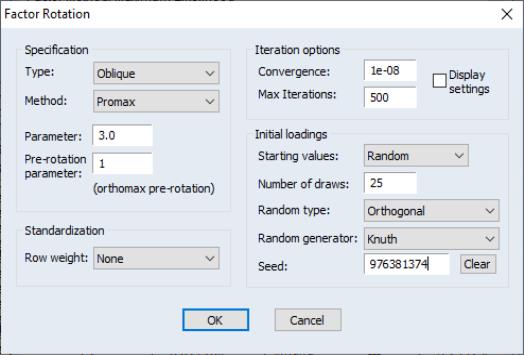Rotating Factors
You may perform factor rotation on an estimated factor object with two or more retained factors. Simply call up the dialog by clicking on the button or by selecting from the factor object menu, and select the desired rotation settings.
The and dropdowns may be used to specify the basic rotation method (see
“Types of Rotation” for a description of the supported methods). For some methods, you will also be prompted to enter parameter values.
In the depicted example, we specify an oblique Promax rotation with a power parameter of 3.0. The Promax orthogonal pre-rotation step performs Varimax (Orthomax with a parameter of 1).
By default, EViews does not row weight the loadings prior to rotation. To standardize the data, simply change the dropdown menu to or .
In addition, EViews uses the identity matrix (unrotated loadings) as the default starting value for the rotation iterations. The section labeled allows you to perform different initializations:
• You may instruct EViews to use an initial random rotation by selecting in the dropdown. The dialog changes to prompt you to specify the number of random starting matrices to compare, the random number generator, and the initial seed settings. If you select random, EViews will perform the requested number of rotations, and will use the rotation that minimizes the criterion function.
As with the random number generator used in parallel analysis, the value of this initial seed will be saved with the factor object so that by default, subsequent rotation will employ the same random values. You may override this initialization by entering a value in the edit field or press the button to have EViews draw a new random seed value.
• You may provide a user-specified initial rotation. Simply select in the dropdown, the provide the name of a

matrix to be used as the starting

.
• Lastly, if you have previously performed a rotation, you may use the existing results as starting values for a new rotation. You may, for example, perform an oblique Quartimax rotation starting from an orthogonal Varimax solution.
Once you have specified your rotation method you may click on . EViews will estimate the rotation matrix, and will present a table reporting the rotated loadings, factor correlation, factor rotation matrix, loading rotation matrix, and rotation objective function values. Note that the factor structure matrix is not included in the table output; it may be viewed separately by selecting from the factor object menu.
In addition EViews will save the results from the rotation with the factor object. Other routines that rely on estimated loadings such as factor scoring will offer you the option of using the unrotated or the rotated loadings. You may display your rotation results table at any time by selecting from the factor menu.


 matrix to be used as the starting
matrix to be used as the starting  .
.